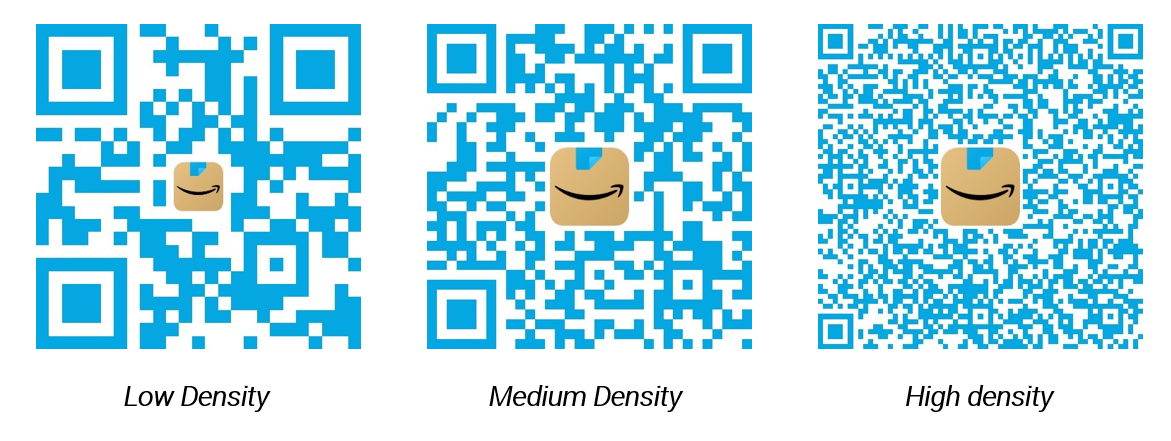Are
Today, both iPhone and Android cameras support QR code scanning, while the codes themselves are getting more customized and branded. Appearing everywhere from print ads and packaging to ecommerce and social apps. Advertisers are no longer just selling products or services but experiences, and the QR code is the point of entry.
If you are planning to implement QR codes for marketing this post is for you and explains how QR codes are optimized for display area and scanning distance.
QR Code Size vs. Scanning Distance
When developing a QR code strategy, marketers need to consider how far away the consumer will be when scanning the code. The goal is to minimize the space needed to display the QR code, while making sure it's still readable and functional.
A lot of marketers get QR codes wrong, making them too small or not suitable for print use-cases. Marketers are often under pressure to fit QR codes into small areas, so they often wonder what is the smallest size for a QR code? Or what is the minimum QR code size for print? The answer depends on a variety of factors such as color, density and the use case for the QR code.
All those variables impact the optimal QR code size.
For example, a QR code in a print ad should be functional from 1 to 2 feet away. A QR code on a TV commercial should function from 8 to 10 feet away. So if the QR code in your print catalog is functional from five feet away, the display size may be too big, meaning you are using space that could be used for the ad itself. If the QR code in your TV ad is making viewers get off the couch to perform the scan closer to the TV, then the QR code is too small.
That said, how do you know when a QR code is too big or too small? What is the minimum size for your QR code considering the marketing channel and the context in which it's scanned? What's the best QR code size for printed material? The answer is in QR code math but first, lets consider the relationship between the different variables within the QR code equation.
QR Code Variables and Relationships
The three most important variables in calculating a QR code are display size, density and scanning distance. Functional scanning distance is determined by display size and density which have an inverse relationship when display size is constant. Consider the example below which is a QR code to an Amazon product page which will open in the app if it's installed on your mobile device.

- Lower code density requires less real estate to function at the desired distance. If QR code density decreases while display area remains constant, functional distance goes up.
- Higher code density requires more display real-estate to function at the desired distance. If QR code density increases while display area remains constant, functional distance goes down.
The density variable is determined by two inputs: the number of characters you’re encoding multiplied by a factor called 'error correction'. This applies to any type of QR code including URLgenius deep links that open apps and websites. The number of characters in a URL, therefore, will directly impact the density of the QR code which will impact the functional scanning distance.
QR Code Optimization
Deep linking platforms like URLgenius will automatically optimize the density of your QR code based on the number of characters in your URL. The character count of any URL can vary greatly of course based on the domain, path information, keywords and tracking parameters.
There are four error correction values and only one is used when generating your QR code: 7%, 15%, 25%, and 30%. As the error correction percentage increases the resulting QR density also increases. Keep the following in mind when creating QR codes with URLs:
- If your URLs are small or about 14-17 characters, error correction should be to 7% which produces a 21x21 code or the smallest available.
- If that same URL was encoded with the highest error correction setting or 30%, you’d get a 29×29 code instead which would cover an area that is nearly twice as big (841 units vs 441 units).
- As mentioned previously, if QR code density increases while the display area remains constant, functional distance goes down.
- At the same display size, a 29×29 QR code will have about half the functional distance of a 21×21 code. Conversely, the scanning distance you gain by using a 21×21 is 90% greater than using a 29×29.
No doubt this can be confusing for marketers and agencies. The good news is that when creating QR codes for links that open apps and websites, your deep linking platform should remove a lot of the guesswork for you by optimizing the calculation. As a general rule, if want to minimize the display size of the QR code while maximizing functional distance, just remember to minimize the number of characters in your URL before creating your deep link.
If you found this content helpful, check out some of our other popular how-to posts:
- How to Create Deep Links for Facebook Events
- How to Create Deep Links for Facebook Reviews.
- How to Make Deep Links for Facebook Videos
- How to Make Deep Links and App QR Codes for More YouTube Subscribers
- How to Make Deep Links and App QR Codes for More Amazon Sales
- How to Setup Your Domain to Host QR Codes and Deep Links
- How to Create Deep Links and App QR Codes for More Spotify Sales
- How to Make Deep Links and App QR Codes for Instagram Hashtags
- How to Create Deep Links for Facebook Groups
- How To Make One Link for iOS and Android App stores to Drive Installs
- How to Generate Facebook Deep Links and App QR Codes
- How to Create Telegram Deep Links and App QR Codes
- How to Create Instagram Deep Links and App QR Codes
- How to Deep Link into SMS Text Messages on iOS and Android
